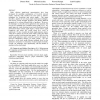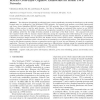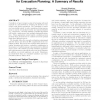605 search results - page 100 / 121 » Reducing complexity in tree-like computer interconnection ne... |
SENSYS
2009
ACM
14 years 3 months ago
2009
ACM
Network protocols are typically designed and tested individually. In practice, however, applications use multiple protocols concurrently. This discrepancy can lead to failures fro...
ICNP
2006
IEEE
14 years 2 months ago
2006
IEEE
— Routing in multi-hop wireless networks involves the indirection from a persistent name (or ID) to a locator. Concepts such as coordinate space embedding help reduce the number ...
VIZSEC
2005
Springer
14 years 2 months ago
2005
Springer
While efficient graph-based representations have been developed for modeling combinations of low-level network attacks, relatively little attention has been paid to effective tech...
JCST
2008
13 years 8 months ago
2008
The allocation of bandwidth to unlicensed users, without significantly increasing the interference on the existing licensed users, is a challenge for Ultra Wideband (UWB) networks....
GIS
2005
ACM
14 years 9 months ago
2005
ACM
Contraflow, or lane reversal, is a way of increasing outbound capacity of a real network by reversing the direction of inbound roads during evacuations. The contraflow is consider...



